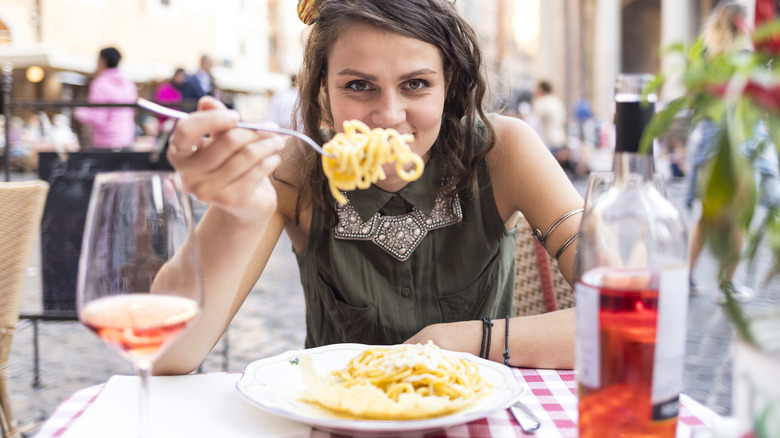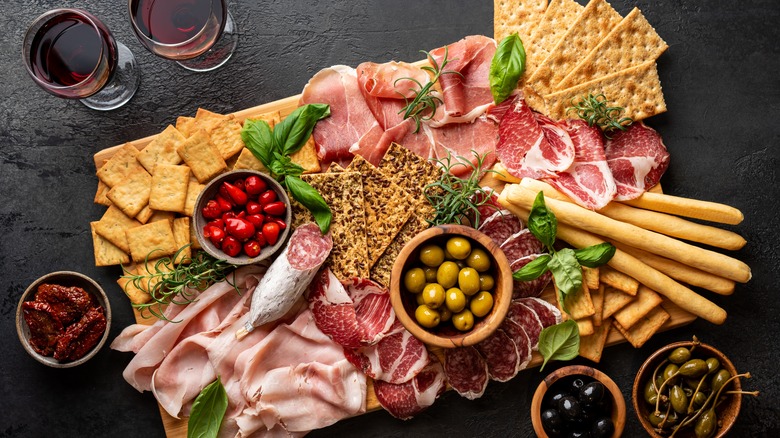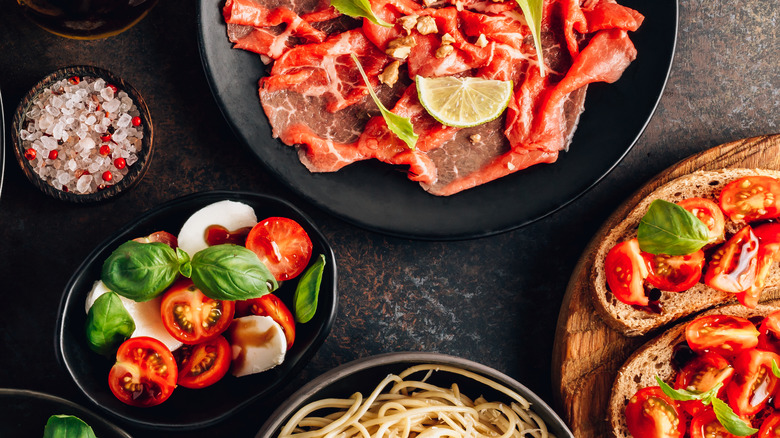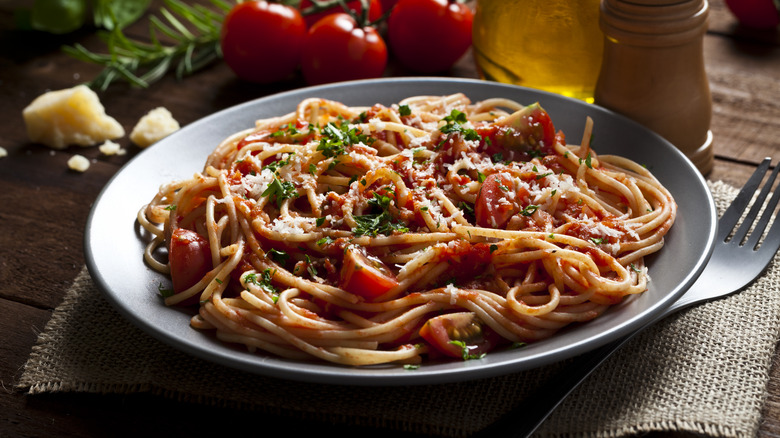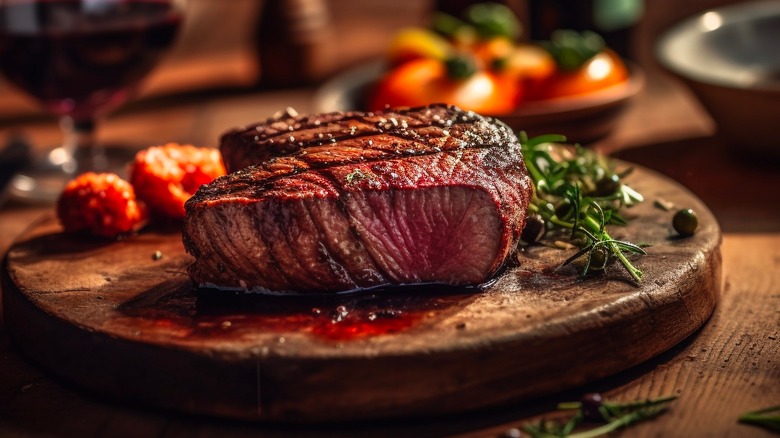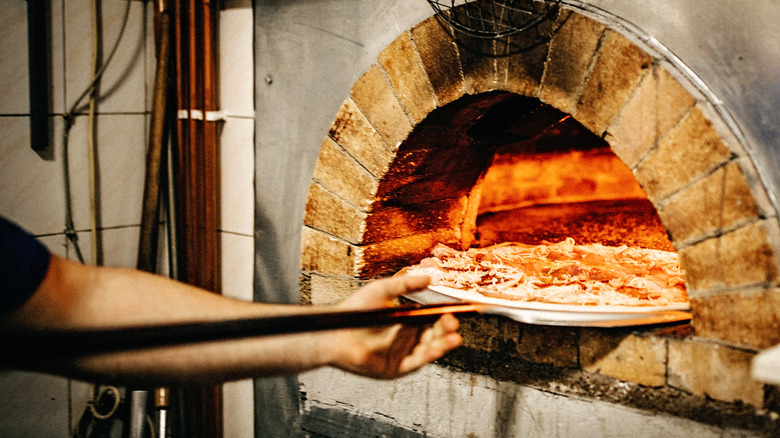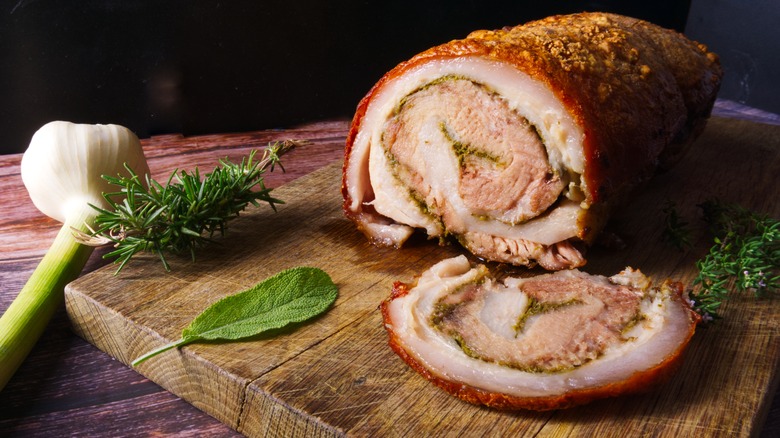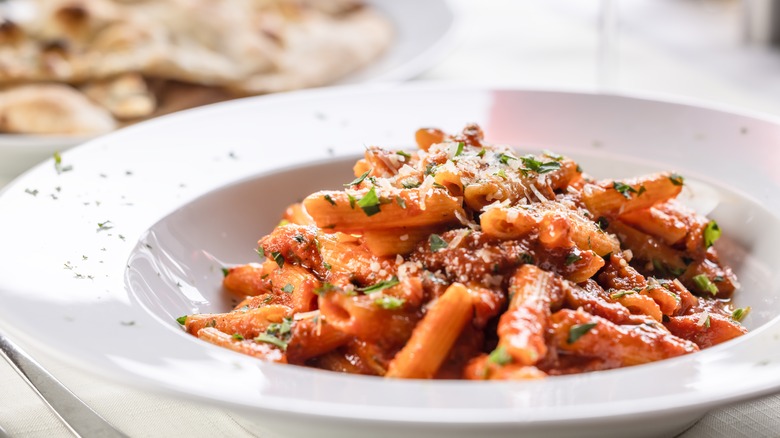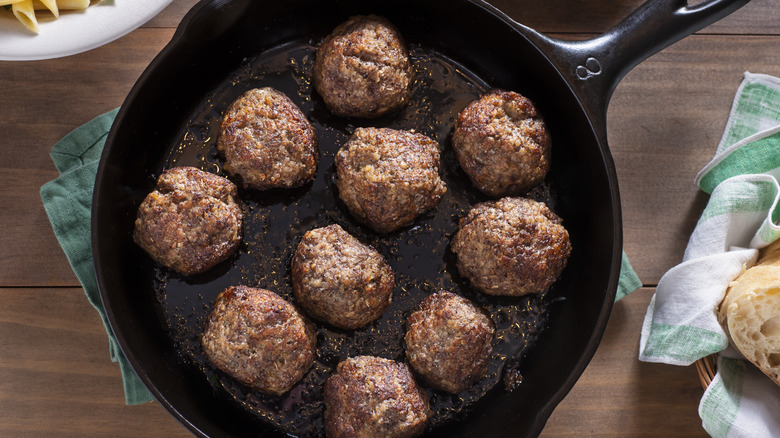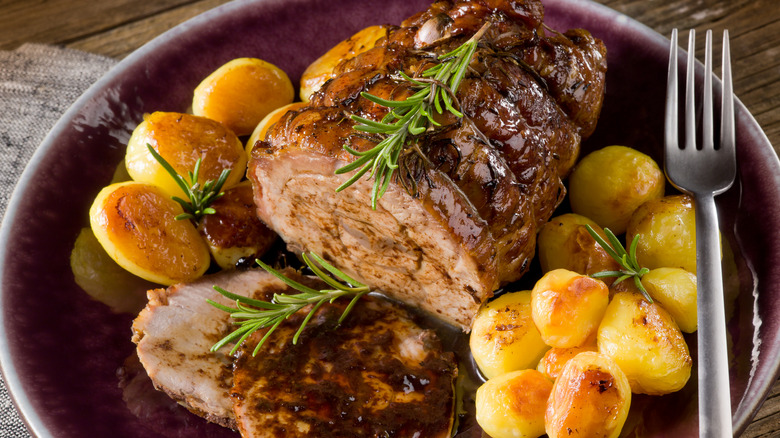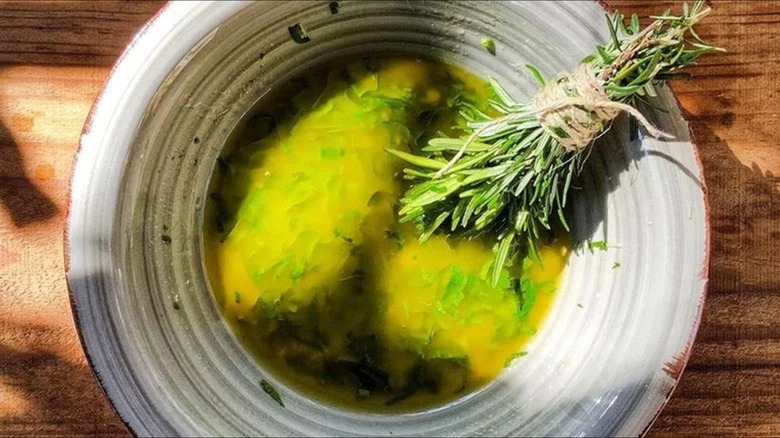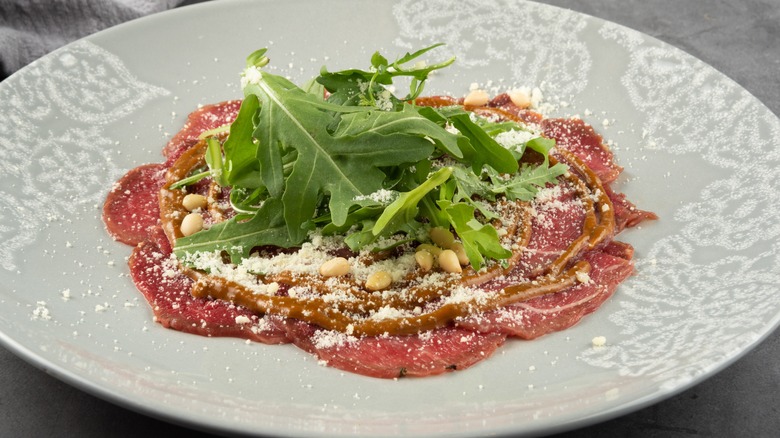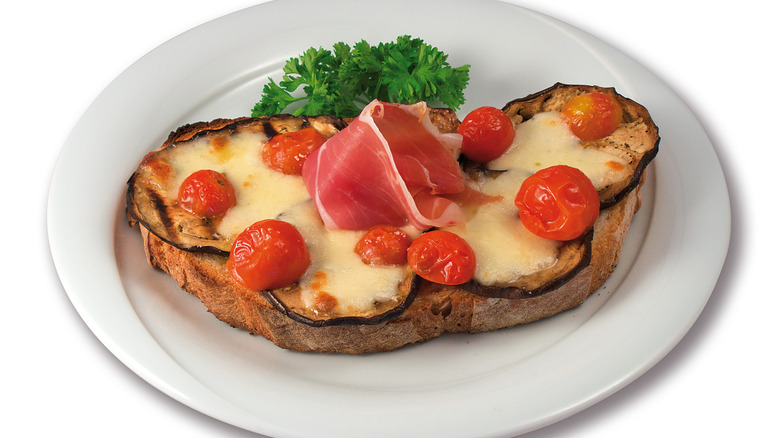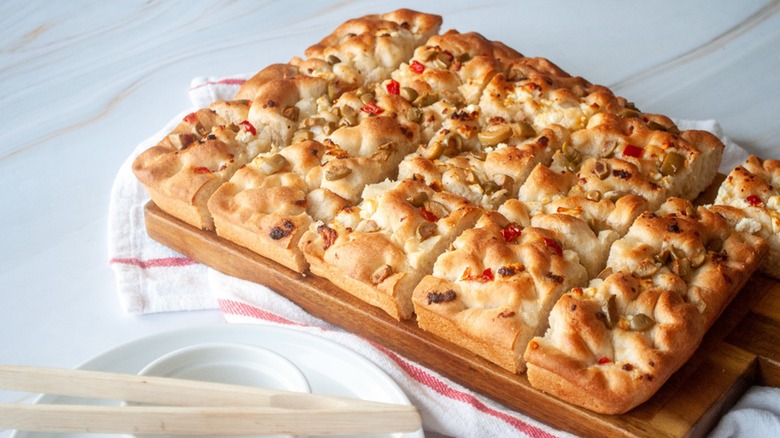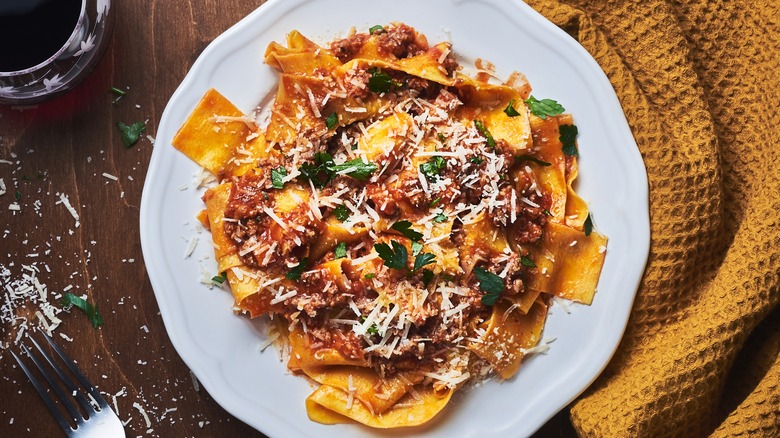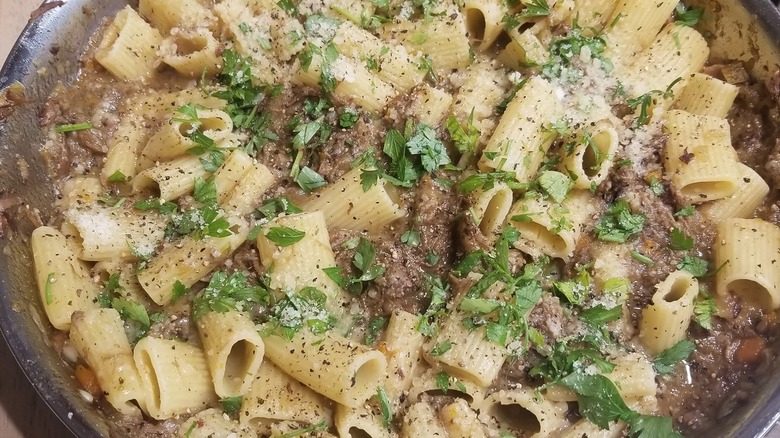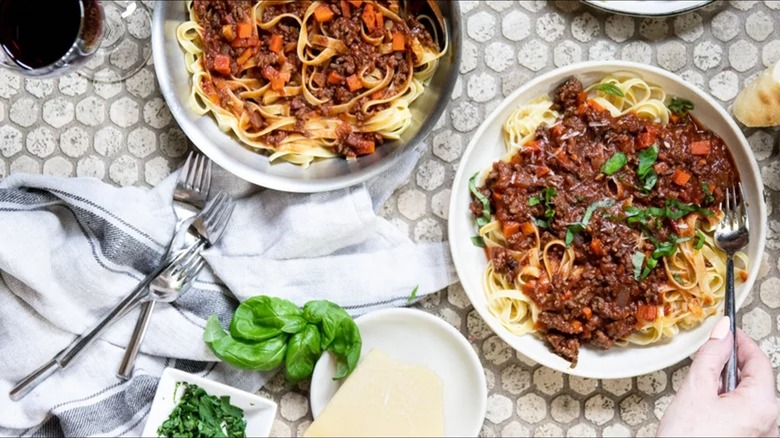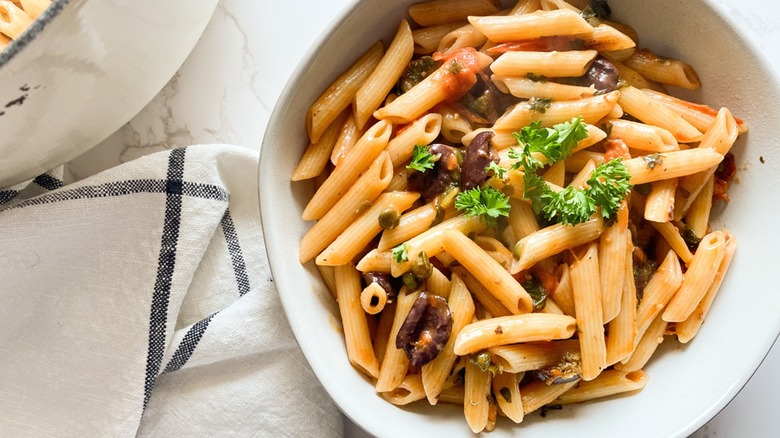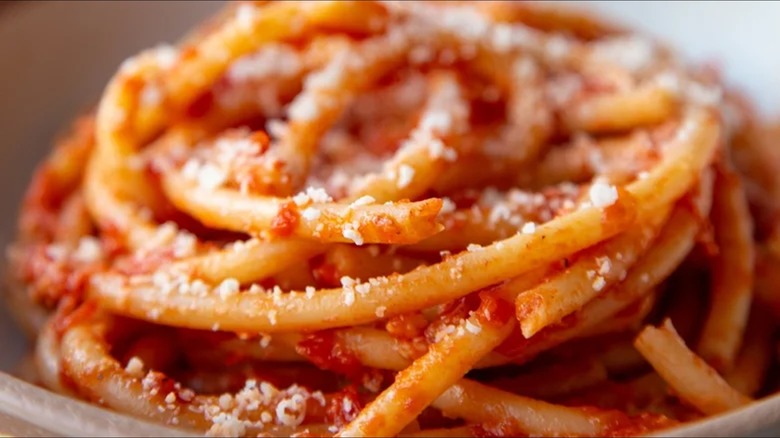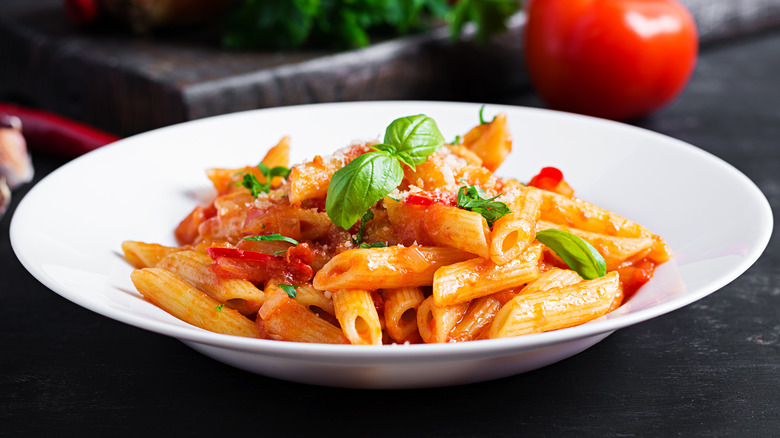24 Essential Words And Phrases To Know At An Italian Trattoria
If you're interested in ordering like a pro at an Italian trattoria without having to consult a translator, it's time you learned a few essential Italian words and phrases. It helps to know what you're getting so that there are no surprises. Plus, once you know what's available, you can seek out restaurants that have menu items you would like to try.
We've collected several words and phrases you're likely to find on an Italian restaurant menu. At the top of the list are names of meal courses, which is a cultural study in itself. We've also included a few cooking-related words, along with types of sauces and Italian food menu items you might like to try that may not be familiar to you. This isn't a comprehensive list by any means. After all, you still will need to know the names of a variety of Italian pastas and cheeses. However, we hope to expand your Italian culinary horizons beyond ordinary dishes like spaghetti, fettuccine, and gelato that you might already know.
Antipasti
It's not uncommon to find the words "antipasti" or "antipasto" as one of the first subheadings on an Italian trattoria's menu. If you see them in that context, it can be easy to guess that they're small dishes like appetizers that you eat before your meal. In fact, antipasti comes from the Latin words for "before" (anti) and "meal" (pastus). Antipasti is the plural form of the word, while antipasto is the singular form.
Antipasti are often similar to what you might find on the perfect charcuterie board. So, you might see items like cheese, cured meats, sausages, olives, dips like pesto, veggies, salads, and bread as antipasti.
Spuntini
Spuntini (spuntino in the singular) are foods that you can eat as appetizers, too. However, spuntini is a broader term that encompasses anything you want to eat before a meal or as a snack instead of just charcuterie-type or pre-meal items. Italy even has places you can go that only serve between-meal snacks.
You can literally eat any type of food as spuntini as long as it's in smaller quantities. It could be antipasti, pizza, dessert, or soup -– it will just be offered in a snack-sized portion.
Primi
Another course you might find on an Italian restaurant menu is primi. Primi means "first," and it's the first course.
Some dishes you can expect in the primi course of the meal include soup or one of the many carby dishes Italy is famous for, like risotto or pasta. Since the expectation is that you will probably follow this dish with meat, primi are not usually large servings, leaving you plenty of room for more food.
Secondi e Contorni
Secondi and contorni make up what we'd normally think of as the main course. The secondi course tends to be the protein part of the meal. So, the secondi section of the menu will include a meat or veggie main dish. However, you shouldn't assume that your main dish will come with a side. Sides are a separate course called contorni.
The secondi section of the menu is where you're likely to find pollo (chicken), bistecca (steak), or pesce (fish), while the contorni section is where you'd have to look for items like grilled veggies and insalata (salads).
Dolci
Hopefully, you've left room for dolci at the end of the meal. The dolci portion of the menu contains yummy desserts.
Italian restaurants have so many great desserts that you may have a difficult time choosing. Granitas (blended frozen fruit) or gelatos (similar to ice cream) can satisfy your craving for something cold and sweet. There are also rich desserts like sweet-cream-cheese-filled cannoli. If you're in the mood for something creamy, look for panna cotta (sort of like pudding) or tiramisu (custard and cookies). You may even find tortas (cakes) or crostatas (pies and tarts).
Piccata
Piccata is a specific way to prepare meat. A piccata-style dish starts with a thin slice of floured meat (usually veal or chicken). Then, the chef sautées the meat rather than deep-fries it and combines it with a lemon butter sauce. A lot of chefs also add capers, but they're not strictly necessary by definition.
Rather than coming from mainland Italy, piccata dishes are believed to have originated with Italian immigrants living in the U.S. in the 1930s. So, it's an Italian dish they don't serve in Italy. Since veal was extremely cheap then, the dish started out being made with veal. However, chicken piccata is also a common today.
Marsala
Marsala is a type of wine that comes from the town of Marsala in Sicily, and it's used for Marsala sauce. A French chef is thought to have created it for Queen Maria Carolina of Naples and Sicily in the 1800s, but it caught on more in the U.S. than in Italy.
Since the sauce includes Marsala wine, it's a rich sauce. However, the base is up to the chef. So, don't be surprised to find Marsala sauce made differently at different restaurants. It could have a mushroom base as easily as a tomato base, and some include cream. You also might find onions, garlic, or even fruits like cranberries in Marsala sauce. Despite being a rich sauce, Marsala is commonly served over chicken or veal. So, next time you see chicken Marsala or veal Marsala on a menu, you'll have at least some idea of what to expect.
Parmigiana
Parmigiana is a dish made with fried eggplants or fried cutlets of chicken or veal, along with mozzarella cheese and tomato sauce. It would be easy to think that dishes labeled Parmigiana must contain Parmesan cheese or come from Parma, Italy. However, it seems that neither of these assumptions is true. Instead, these recipes are made with mozzarella cheese and only sometimes Parmesan. The dishes also seem to trace back to Campania and Sicily, which are both many hours south of Parma. However, the way the ingredients stack in the eggplant version of the dish is reminiscent of window shutter slats, which are called "parmiciana" in Sicily.
While other vegetables like zucchini may have been included in some of the first parmigianas, eggplant became the favorite version in Italy. In the U.S., it's common to find chicken, veal, and eggplant parmigianas, though the name is often simplified. Whether the dish is labeled chicken parmigiana or chicken parmesan, there's really no difference.
Al forno
Menu items listed as being "al forno" are ones that come "from the oven." However, the type of oven they're usually talking about isn't the type most of us have in our home kitchens. Instead, they're often big woodfire brick ovens or electric ones that simulate the smoke and extreme heat of a brick oven.
Breads and pizzas are some of the most obvious menu items that come al forno. However, if you see a casserole or other menu item listed as being al forno, it was either completely baked or finished off at high temperatures in the oven. The cheese in dishes like lasagna al forno or conchiglioni al forno gets bubbly and crispy on top using this cooking method.
Spumoni
You've likely heard of gelato, but an ice-cream-type dessert you can find on Italian menus that's a little less well known is spumoni. Spumoni is gelato combined with whipped cream and a variety of mix-ins. While gelato starts with less cream and eggs (or no eggs) and more milk than custard, adding in whipped cream to make spumoni doesn't create a more custard-like dessert. Instead, you get a fluffier version of gelato. Recipes for spumoni often call for layering it like a cake with different flavors in each layer. It's also often served in slices like cake.
While the most common spumoni you'll encounter has layers flavored with chocolate, pistachio, and cherry, you'll also see vanilla subbed in for chocolate so that the dessert layers correspond to the colors of the Italian flag. However, the mix-in options are endless. You might see candied fruits or nuts as well as cookies in the mix.
Porchetta
If you find porchetta (say "por-ketta") on the secondi menu at an Italian trattoria, you're in for a treat. The word translates to "little pig," so it's traditionally a pork dish. It starts with a flat piece of boneless pork that includes fat and skin and is rolled around a layer of herbs like fennel before roasting. The pork could be anything from pieces of a whole pig to cuts of pork belly or pork shoulder.
This rolled pork dish is not only delicious when eaten on its own, but it's also often served as the main ingredient of a panino sandwich. In fact, it shines best when there's nothing on the sandwich except porchetta.
Pomodoro
Pomodoro is a tomato sauce that came out of Naples, Italy. While there are variations, the base of this tomato sauce tends to contain olive oil, garlic, onions, basil, salt, and pepper. So, it's fairly simple. The first mention of pomodoro sauce was in the "Cuoco Galante" cookbook by Vincenzo Corrado in 1778. However, it didn't become popular on pasta until the 1800s.
Because of its simplicity and versatility, pomodoro sauce can be found on various foods. You're as likely to find it on pasta or pizza as you are on meatballs, seafood, or vegetables.
Polpette
If you see polpette on an Italian restaurant menu, it's a food you're already familiar with: meatballs. The word either comes from the Latin word for boneless meat, "pulpa," or the French word for eyelid, "paupiere." If the name was inspired by eyelids, it's because your hands make an opening and closing eyelid motion when forming meatballs. While the origin of meatballs isn't clear and they weren't originally Italian, we've come to associate them with Italy.
In Italy, you're more likely to find polpette as a main course rather than a spaghetti topping like in the U.S. And you'll also find them in different sizes as well. There are even some as small as marbles.
Arrosto
If you see a dish that is arrosto, it means that it's roasted. You'll usually see the word "arrosto" used with meat dishes. However, veggies like peppers can be roasted, too. So, the word doesn't just describe the types of roasts that you'd see for a Sunday meal.
Some dishes you might see at an Italian restaurant include arrosto di vitello (veal), arrosto di maiale (pig), and pollo (chicken) arrosto. Meanwhile, arrosto mixto (mixed) includes both meat and vegetables.
Salmoriglio
If you're wondering what exactly salmoriglio is and how it's used, know that it can be both a marinade for pre-cooking and a dressing to add after cooking. The ingredients list starts with lemon juice, warm water, and olive oil. Plus, it contains fresh oregano and garlic for flavoring. There are a few variations. Cooks in Calabria add parsley if it's going to be used with fish, and others use mint instead of oregano. Meanwhile, Eolie Islanders replace lemon juice with white wine, and Sicilians sometimes replace the water with tomato juice.
You're likely to find salmoriglio as a marinade for all kinds of meats and fish. While it works as a dressing for salads like a caprese, it also really shines on grilled or roasted veggies like potatoes or cauliflower romanesco.
Carpaccio
When you're looking at appetizers on an Italian menu, you're likely to come across carpaccio. The original version is a plate of thin herb-and-vinegar marinated raw meat topped with a dressing made from lemon juice and olive oil with an addition of capers, sliced onions, herbs or greens, and Parmesan cheese. The story goes that Chef Giuseppe Cipriani first created it in the 1950s for Countess Amalia Nani Mocenigo at Harry's Bar in Venice to suit her no-cooked-meat diet.
The Countess's carpaccio was made from beef, but you can find it made today with all sorts of thinly sliced meats and fish, ranging from veal to tuna. In keeping with modern diets, chefs also thinly slice fruit and vegetables to make vegetarian carpaccio.
Crostone
Fancy toasts are nothing new, and at Italian restaurants, you'll see them called crostone. Crostone is related to the word for little bread crusts: "crostino." However, these are bigger versions.
There's an endless array of ingredients that can mix and match on crostone. You might see a crostone with pears and figs. Tomato-and-cheese-based ones might feature cannellini beans, prosciutto, or fresh basil. The sky is the limit with toppings, so nearly any Italian ingredient is fair game.
Focaccia
If you've missed the focaccia bread craze, you'll probably want to order this bread to see what all the fuss is about. Focaccia is a yeasty and fluffy Italian flatbread made with lots of olive oil in a flat pan. There are often lots of indentions in the bread made from dough bubbles and fingertip pokes during the creation.
The flavors vary from cook to cook. It's often infused or topped with herbs, cheeses, garlic, vegetables, and sometimes even anchovies.
Ragù
Ragù is a catch-all word for a meat-based pasta sauce. So, when you hear "ragù," you know you're getting a robust dish that already comes with meat. Most of these sauces are tomato-based or wine-based sauces that stew for a long while to incorporate all the flavors. The first ragù in the late 1700s was inspired by French ragoût (meat stew) but was a variation made to serve over pasta.
There are several types of ragùs you might come across in an Italian trattoria. Two of the more popular ones are next on our list: Bolognese and Genovese ragùs.
Genovese
Pasta topped with a Genovese sauce or la Genovese Napoletana benefits from the rich flavors involved. This long-cooking sauce is made with a base that contains a lot of onions, along with carrots, celery, beef stew meat, and white wine. We're talking six pounds of onions to two and a half pounds of beef here, so it's intense. Some people also add a little bit of tomatoes for flavor. Genovese sauce originated in Naples, but stories say that it either came to Naples via Genoan sailors or a chef from Genoa.
Genovese sauce is especially delicious over pasta. You'll almost always see it served over fat pieces of rigatoni pasta.
Bolognese
The difference between marinara sauce and Bolognese sauce boils down to the fact that Bolognese sauce is a ragù and contains ground or minced meat. Different chefs have different recipes for it, but all of them use ground or chopped beef and tomatoes, and many also use both butter and olive oil in it. The sauce might have other meats like ground veal or pork mixed in, too. Other additions may include chicken livers, cured meats like pancetta, milk or cream, or red or white wine. There's even a white version of Bolognese sauce without tomatoes.
The pasta with Bolognese sauce is traditionally served with egg-based tagliatelle noodles. You may see it with other flat and long noodles like fettuccine. It's also delicious with tubed-shaped pasta like rigatoni that can collect the meaty sauce inside.
Puttanesca
Puttanesca has a risqué origin story hidden in its name. The Italian word "puttana" means "prostitute," so the name of this sauce translates to "in the style of the prostitute." It possibly got its name from its pungent ability to attract men to the red light district where ladies were cooking this easy-to-make sauce either for themselves or their clients. Another story is that a restaurant owner in the 1950s first made it when he didn't have a lot of ingredients left at the end of the night for hungry customers who asked for "una puttanata qualsiasi." Even though the phrase means "any whore," the implication was for the chef to throw together whatever basic ingredients they had available. The ingredients used to make the sauce turned out to be tomatoes, capers, and olives.
Today's sauce has evolved to include even more odiferous ingredients like garlic and anchovies, along with red pepper flakes and herbs like oregano and basil. It's common to find it served as spaghetti alla puttanesca. As long as it doesn't include anchovies, it tends to be a vegetarian dish.
Amatriciana
The recipe for Amatriciana goes back almost one thousand years to a town nearly 100 miles north of Rome called Amatrice. Shepherds would bring cheese and cured pork jowl called guanciale with them out into the pastures, where they would mix them together with pasta when hungry. It wasn't until centuries later that Amatriciana sauce began to include tomatoes imported from the New World. It was a Roman chef in the 1800s who popularized the dish in his cookbook and served it to the pope's court.
One of the most common dishes is bucatini all'Amatriciana. It's served over bucatini pasta — a pasta that's a little thicker than spaghetti and has a hole running through the middle like macaroni. With bucatini pasta not being super common, you're probably more likely to find it over spaghetti or other types of pasta.
Arrabbiata
The word "arrabbiata" means "angry," which possibly refers to chefs going mad with lots of spicy ingredients or to people whose face turns red (as if angry) from the spices. After all, this tomato-based sauce gets its spicy kick from lots of garlic and hot chili flakes. One origin story says this sauce was created in the Lazio region of Italy by peasants sneaking into their landlords' kitchens to add hot ingredients to their sauces in spiteful acts of angry rebellion. Whatever the origin of the sauce or its name, a Roman chef named Antonio Cecchini popularized it in the 1920s at his restaurant called Le Arrabbiate.
Penne pasta is a common vehicle for arrabbiata sauce. There are also different levels of heat for this sauce, depending on how much red pepper flakes go into it. It's simple, so you'll usually find only grated Parmesan and maybe some fresh herbs like parsley atop this sauce.
